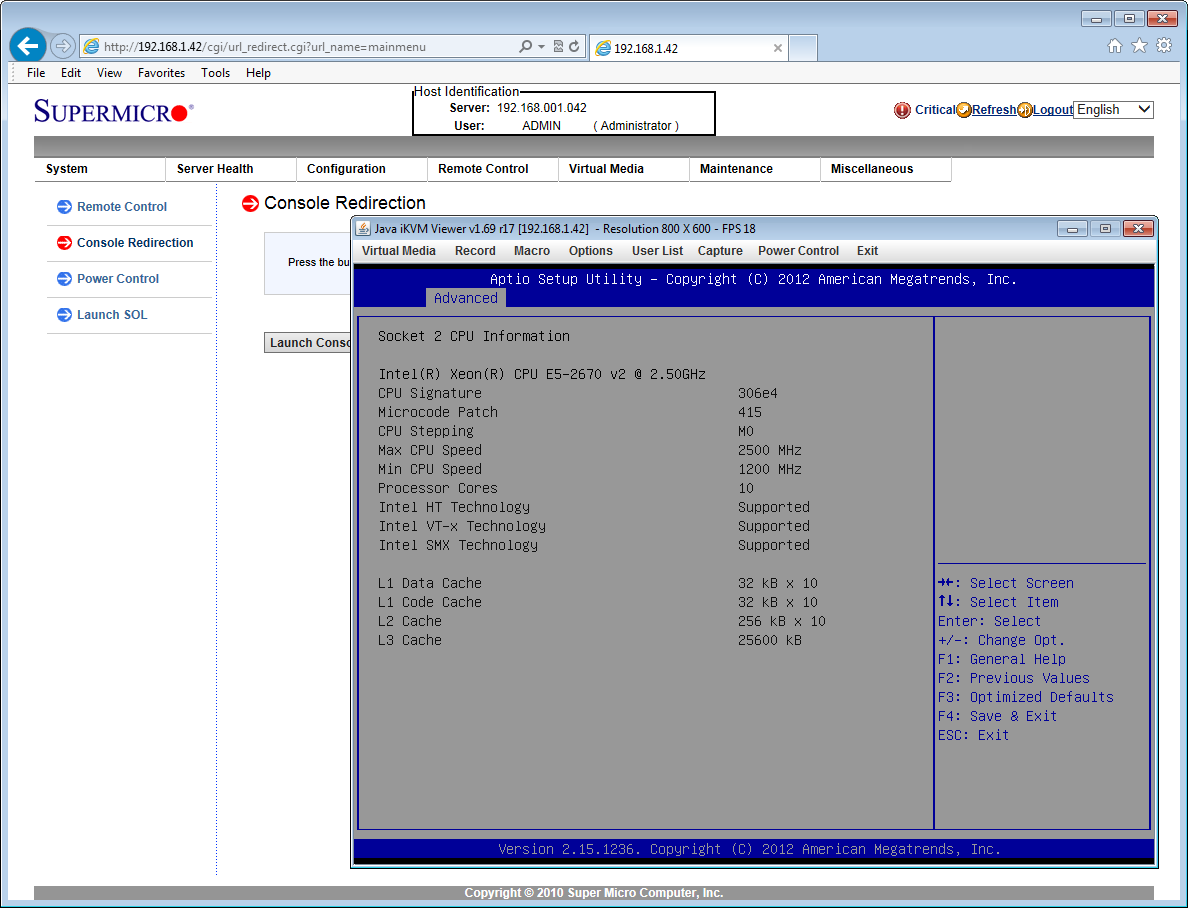Boston Value Series 361 G8 review
Intel's latest E5-2600 V2 Xeons provide high power and embedded protection.


The VS 361 G8 packs a lot of features into its compact 1U chassis and combines them with a high processing density. Storage features are well thought out, 10-Gigabit is standard and the integral BBUs could be life savers in a blackout.
-
+
High CPU core count; Integral BBUs; Good storage features; Embedded 10-Gigabit; Improved remote management
-
-
Chassis lid difficult to fit

Intel announced its latest E5-2600 v2 Xeons at IDF 2013 and Boston has already rolled out servers packing these new high core density CPUs. But that's not the only unique feature of the VS 361 G8. It's also the first rack server to incorporate its own battery backup system.
So what advantages do the second generation Xeons bring? A key feature of Intel's new processors is the drop to a 22nm fab process. This allow more cores to be packed onto the chip and better performance without a significant increase in power demands. Each core also has 2.5MB of L3 cache and adds support for 1,866MHz DDR3 memory.
Boston supplied the VS 361 G8 to us with a pair of 10-core 2.5GHz E5-2670 v2 Xeons each with 25MB of L3 cache. The equivalent first generation E5-2670 may have had an extra 100MHz to play with but it only had 8 cores and 20MB of L3 cache for the same TDP rating.
Aimed at 2P server applications, the v2 family is big with speeds for its 18 members ranging from 1.7GHz to 3.5GHz. At the top are the 2.4GHz E5-2695 V2 and 2.7GHz E5-2697 V2 which deliver 12 physical cores and 30MB of L3 cache.

Accessed from the front of the server, the pair of 200W BBUs keep it running for up to five minutes in a blackout
Superior storage
Boston has chosen a fine package to showcase the new Xeons as this 1U all-Supermicro system is bursting with features. There's room at the front for eight SATA III/SAS 2 SFF hot-swap hard disks and the carrier release catches have been redesigned so they're easier to remove.
Sign up today and you will receive a free copy of our Future Focus 2025 report - the leading guidance on AI, cybersecurity and other IT challenges as per 700+ senior executives
Supermicro's server motherboards have traditionally offered a confusing choice of storage options and their plethora of SAS and SATA ports often catch system builders out. Not so with the VS 361 G8 as Boston has cabled the drive backplane directly to the pair of SAS2 SCU (storage control unit) ports on the X9DRW-7TPF motherboard.
These are managed by an LSI 2208 chip which support all key RAID array types including RAID-6 and -60. The price we've shown includes four 300GB Toshiba SAS2 SFF drives and the cabling arrangement allows you to add more drives and expand an existing array onto them.

The server's embedded RMM provides remote control as a standard feature
Design and build
Internal design is tidy with the LGA 2011 CPU sockets staggered down the board to maximise air flow from the six dual rotor cooling fans. Each socket has eight DIMM slots and the price includes a healthy 64GB of fast 1,866MHz ECC DDR3 memory.
There's room to expand as the central riser has two 16X PCI-Express 3.0 full-height slots on one side and an 8X low-profile slot on the other. Network connections don't get any better as the motherboard has dual embedded Gigabit ports and two Broadcom 10-Gigabit SFP ports.
We have one gripe about build quality as we had a job getting the server's lid back on after our internal examination as it's too tight a fit at the sides. Admittedly, our review system is an early sample but Supermicro should take a look at HP's and Dell's 1U rack servers to see how to do this properly.

From the RMM console you can set a graceful shutdown time for when the server is on battery backup
Power protection
Power is handled by dual 750W hot-plug PSUs at the rear. The hot-plug Battery Backup Units (BBU) at the front are linked into the power backplane and can deliver 200W of output power for up to 5 minutes.
They don't provide UPS-like power conditioning and are designed to protect the server in a blackout. The embedded RMM controller is fully aware of the BBUs and can be configured to gracefully shut down the server before they run out.
We tested this by setting a shutdown delay of 240 seconds from the RMM web interface and then pulling the plugs. Both PSUs sounded audible alarms and we could see from the web console that the BBUs were in action.
After four minutes the RMM gracefully shut Windows Server 2012 down and powered the server off. With power restored, we used the RMM web console to remotely turn the server back on.
The new Xeons deliver on their power promises as well with our meter recording idle and peak readings of 135W and 330W. Boston's Value Series 380 G8 2U rack server has slightly larger PSUs but its pair of 2.6GHz E5-2670 8-core Xeons recorded idle and peak readings of 162W and 349W.

The revamped SuperDoctor 5 web console can monitor the BBUs and all storage
Remote management
Along with a redesigned RMM console, Supermicro has finally revamped its pensionable SuperDoctor. It uses the local Windows SNMP agent to remotely monitor the server and version 5 looks a lot smarter.
It provides heaps of graphs and speedo dials for fans, temperatures, voltages, PSUs plus the BBUs and can send out email alerts if any component steps outside its threshold values. It also monitors the embedded RAID controller and hard disks although the LSI MegaRAID utility is used to configure new arrays.
Conclusion
The latest E5-2600 V2 Xeons give the VS 361 G8 an impressive processing density for a 1U rack server. Storage and networking are well presented and the integral BBUs means you don't have to waste valuable rack space with a separate UPS.
Verdict
The VS 361 G8 packs a lot of features into its compact 1U chassis and combines them with a high processing density. Storage features are well thought out, 10-Gigabit is standard and the integral BBUs could be life savers in a blackout.
Chassis: 1U rack
CPU: 2 x 2.5GHz E5-2670 V2 Xeon
Memory: 64GB 1,866MHz ECC DDR3 (max. 512GB)
Storage: 4 x 300GB Toshiba SAS2 SFF hot-swap hard disks (max. 8)
RAID: LSI 2208 SAS2
Array support: RAID0, 1, 10, 5, 50, 6, 60
Network: 2 x Gigabit, 2 x 10GbE SFPs
Expansion slots: 3 x PCI-e 3.0
Power: 2 x 750W hot-plug PSUs; 2 x 200W BBUs
Management: Supermicro RMM with 10/100 port
Warranty: 3yrs on-site NBD
Dave is an IT consultant and freelance journalist specialising in hands-on reviews of computer networking products covering all market sectors from small businesses to enterprises. Founder of Binary Testing Ltd – the UK’s premier independent network testing laboratory - Dave has over 45 years of experience in the IT industry.
Dave has produced many thousands of in-depth business networking product reviews from his lab which have been reproduced globally. Writing for ITPro and its sister title, PC Pro, he covers all areas of business IT infrastructure, including servers, storage, network security, data protection, cloud, infrastructure and services.
-
 Qualcomm the data center with $2.4 billion Alphawave Semi acquisition
Qualcomm the data center with $2.4 billion Alphawave Semi acquisitionNews The move sees Qualcomm absorb Alphawave Semi’s portfolio of custom silicon, high-speed connectivity solutions, and chiplets
By Daniel Todd Published
-
 ‘If software development were an F1 race, these inefficiencies are the pit stops that eat into lap time’: Why developers need to sharpen their focus on documentation
‘If software development were an F1 race, these inefficiencies are the pit stops that eat into lap time’: Why developers need to sharpen their focus on documentationNews Poor documentation is a leading frustration for developers, research shows, but many are shirking responsibilities – and it's having a huge impact on efficiency.
By Ross Kelly Published
-
 OpenAI says GPT-5.2-Codex is its ‘most advanced agentic coding model yet’ – here’s what developers and cyber teams can expect
OpenAI says GPT-5.2-Codex is its ‘most advanced agentic coding model yet’ – here’s what developers and cyber teams can expectNews GPT-5.2 Codex is available immediately for paid ChatGPT users and API access will be rolled out in “coming weeks”
By Ross Kelly Published
